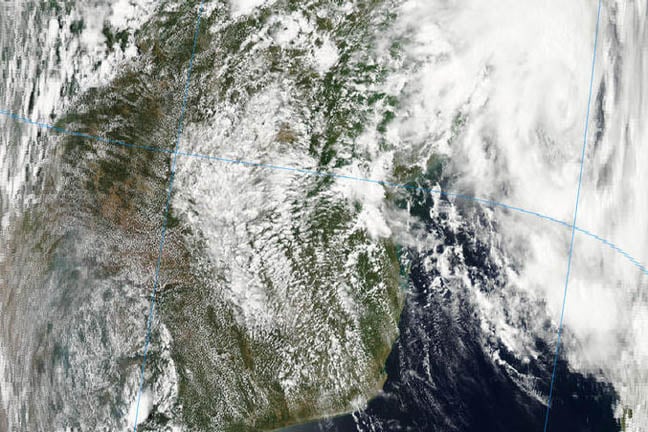Tropical depression Dando, which made landfall on 16 January north of the capital Maputo, was the fiercest tropical storm to strike the area since Storm Domoina in 1984. A few days later Cyclone Funso veered from an expected landfall in the north of the country and headed back into the Mozambique Channel, but the effects of the weather system were still felt.
Dulce Chilungo, Mozambique’s director of the Technical Council for Disaster Management, told a press briefing in Maputo on 25 January that 16 people had died in Zambézia and nine in Gaza Province.
Dando has washed away about 60 metres of the main north-south road about 100km north of Maputo, where wind speeds of up to 70km/h and heavy rainfall led to flooding and damage to houses and schools, says a draft report by the Red Cross and Red Crescent Societies obtained by IRIN.
“The situation was exacerbated by the heavy rainfall in [neighbouring] South Africa and Swaziland which caused a steady increase of water levels in the Maputo, Umbeluzi and Incomati Basins, flooding low-lying areas in Magude and Chókwe,” the draft report said.
Citing Mozambique’s National Disaster Management Institute (INGC), the draft report said that in Gaza Province flooding (caused by Dando) had affected 5,393 families, while in Zambézia about 2,571 families were affected by Funso up until 23 January 2012.
INGC also forecast in the first quarter of 2012 “normal to above normal rainfall… throughout the country with the exception of Cabo Delgado, Nampula and part of the northern province of Zambézia”.
Jorge Unamusse of Mozambique’s Red Cross told IRIN the southeastern province of Inhambane was also being monitored for flooding following continued heavy rain.
Mozambique’s Technical Council of Disaster Management has been holding daily meetings with the UN Office for the Coordination of Humanitarian Affairs and the Mozambique Red Cross since 16 January, and an Orange Alert has been declared, to ensure preparedness by all relevant agencies.
Preparedness activities
Preparedness activities include distribution of bicycles, stretchers, masks, gloves, megaphones and boats, and the cleaning out of storm drains.
Unamusse said a temporary camp in Maputo for about 440 people had been set up for those displaced on the outskirts of the city by flooding caused, among other things, by poor maintenance of storm drains.
In 2000 Cyclone Eline made landfall near the central Mozambique port city of Beira, accompanied by 260km/h winds, causing widespread flooding and the deaths of at least 700 people and the displacement of about a million others.
Funso remains active in the Mozambique Channel and at 10am on 25 January was about 230km off the coast of Inhambane Province, Mozambique’s National Institute of Meteorology's chief forecaster Sergio Buque told IRIN.
“Its intensity decreased from category four to category three with sustained winds exceeding 155km/h. Rain with thunderstorms and strong winds, above 70km/h, will continue to affect the Inhambane districts of Inharrime, Panda, Jangamo, Homoíne, Inhambane City, Maxixe, Morrumbene, Massinga Vilankulo and Inhassoro,” he added.
go/cb
This article was produced by IRIN News while it was part of the United Nations Office for the Coordination of Humanitarian Affairs. Please send queries on copyright or liability to the UN. For more information: https://shop.un.org/rights-permissions





